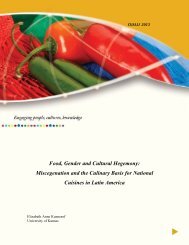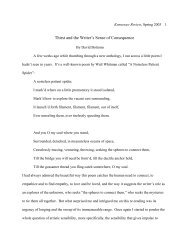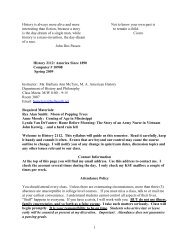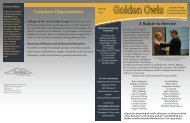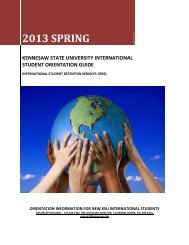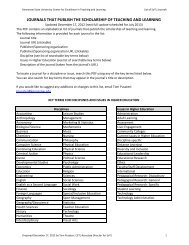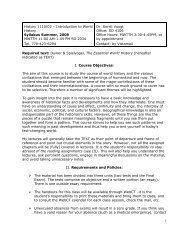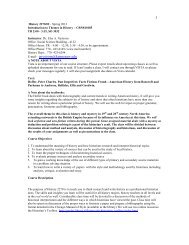Beyond Rosie: Women in World War II - Kennesaw State University
Beyond Rosie: Women in World War II - Kennesaw State University
Beyond Rosie: Women in World War II - Kennesaw State University
You also want an ePaper? Increase the reach of your titles
YUMPU automatically turns print PDFs into web optimized ePapers that Google loves.
<strong>Beyond</strong> <strong>Rosie</strong>: <strong>Women</strong> <strong>in</strong> <strong>World</strong> <strong>War</strong> <strong>II</strong><br />
Three ‘Into the Factories’<br />
Time Required 1 – 2 Class Periods<br />
PAGE 22<br />
Overview:<br />
Men leav<strong>in</strong>g to fight <strong>in</strong> <strong>World</strong> <strong>War</strong> <strong>II</strong> created a labor shortage <strong>in</strong> <strong>in</strong>dustries <strong>in</strong> the United<br />
<strong>State</strong>s. To fill this void and ma<strong>in</strong>ta<strong>in</strong> the United <strong>State</strong>s’ <strong>in</strong>dustrial and economic strength,<br />
the government looked to women as a source of labor. <strong>Women</strong> entered traditionally maledom<strong>in</strong>ated<br />
jobs <strong>in</strong> armaments, farm<strong>in</strong>g, and <strong>in</strong>dustry <strong>in</strong> unprecedented numbers. At least<br />
6 million women <strong>in</strong> the United <strong>State</strong>s answered the call from the government, which used<br />
propaganda posters and film to conv<strong>in</strong>ce women to contribute to the war effort.<br />
Propaganda served an important purpose <strong>in</strong> women enter<strong>in</strong>g the work force, and slogans<br />
such as “<strong>Women</strong> <strong>in</strong> <strong>War</strong> – We Can’t W<strong>in</strong> Without Them” began to appear. These propaganda<br />
posters usually displayed pretty, well-dressed women and downplayed how hard and<br />
gritty the work would be. The idea was to conv<strong>in</strong>ce women that they could be fem<strong>in</strong><strong>in</strong>e and<br />
still be valuable to the war effort.<br />
<strong>Women</strong> faced several obstacles, <strong>in</strong>clud<strong>in</strong>g prejudice <strong>in</strong> the work force, doubt from their<br />
husbands and male workers, and even a lack of confidence <strong>in</strong> themselves. At first, <strong>in</strong> 1941,<br />
only women who were already <strong>in</strong> the labor force made the change to wartime production.<br />
Eventually many women, both black and white, left domestic jobs that paid as little a $14 a<br />
week to work <strong>in</strong> shipyards and factories for as much as $37 a week. The government hoped<br />
that girls graduat<strong>in</strong>g from high school would put off college to work <strong>in</strong> the factories. Millions<br />
of unmarried women and later married housewives, answered the call of the government.<br />
<strong>Women</strong> riveted, welded, built airplanes, tra<strong>in</strong>s, and ships, worked <strong>in</strong> offices as typists or<br />
secretaries, made cloth<strong>in</strong>g for soldiers, and even worked on farms <strong>in</strong> food cultivation.<br />
Through the help of women, agriculture as well as <strong>in</strong>dustry thrived dur<strong>in</strong>g the war. In armaments<br />
<strong>in</strong>dustries, women packed parachutes and made guns, bombs, and other weapons<br />
to help the American troops. <strong>Women</strong> work<strong>in</strong>g <strong>in</strong> airplanes helped to weld, work on eng<strong>in</strong>es,<br />
fix propellers, and riveted the metal together. Similar duties were performed by women<br />
work<strong>in</strong>g <strong>in</strong> shipyards.<br />
Almost 50% of women <strong>in</strong> the United <strong>State</strong>s worked dur<strong>in</strong>g the height of wartime production<br />
between 1943 and 1944. At first, more married women worked than s<strong>in</strong>gle women. At<br />
least two-thirds of these women worked due to necessity before the war and shifted to high<br />
pay<strong>in</strong>g jobs dur<strong>in</strong>g wartime while the rema<strong>in</strong><strong>in</strong>g one-third were housewives before the war.<br />
Despite these changes, however, the government cont<strong>in</strong>ually rem<strong>in</strong>ded women that once<br />
the war was over, they would return to their pre-war occupation.



